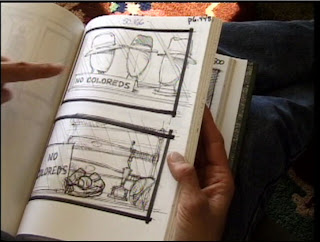I work with a lot of low budget
filmmakers who wisely want to storyboard their films, however, as
the “low budget” part hints at, they do have a limited budget and
storyboarding the whole film is just not an option (unless they
kidnap an artist, lock them in a basement and force them to sketch
every second of the film under threat to their pets...their cute,
adorable pets...I do not suggest this method). This is where picking
which scenes to storyboard can make a huge difference. Here are a
few of the main reasons to storyboard a scene:
1) CGI
Obvious reason, right? It's
complicated, lots of people need to be on the same page, it's visual,
and it won't be seen until after shooting is complete. Storyboard it!
["Candybar", Director: Mathew August]
2) Action Scenes
Again, complicated, lots of people
involved and safety can come into play here. You might not want to
storyboard out a full fight scene down to each punch since that's
where your fight choreographer and stunt people really come into
play. But for the rest, storyboards can help you work out where you
want those cameras to be and where you want the fight staged in
relation to the cameras.
["Widow Creek", Director: Michael Merino]
3) Visual Storytelling
These are my favorite boards to do.
Visual storytelling at its purest. You have a scene with no dialog
and all the story is being told through imagery. Or maybe you
do have some dialogue
but
need to convey a subtext through the action.
Alternately
there is a style or mood you want the audience to experience.
Usually these are the parts of your screenplay where there are a ton
of descriptions and very little dialogue. Storyboards are your
bestest buds in the whole world for those scenes.
["Juliebug", Director Michael Willer]
4) Complex Scenes
There might not be CGI or action or
even be that visually important, but it may end up being a pain in
the tuchis to shoot. We are talking about scenes with a ton of
people, a complicated or dangerous prop, or one where there is just a
lot of movement going on. Storyboarding out these scenes helps to
get everyone on the same page and hopefully limits some surprises on
shooting day. These are not “musts” to storyboard, but are worth
it if your budget allows.
["Reed's Commercial", The Lighthouse Film
Company, Director Brad Walker]
Now, if your budget is a bit bigger or
you don't have a lot of the aforementioned types of scenes, here are
some other scenes that it can be beneficial to invest in storyboards
for:
5) Highly Emotional Scenes
It's the all important emotional climax
of the film! How can you best use your camera placement and movement
and staging to convey those emotions? Do you want to pull back,
leave the person to grieve in private or get all up in their face and
have the audience see every tear that trails down their cheek. One
word....storyboard!!! You can test out a lot of options for a lot
less expense with storyboards. The cost of storyboards is minor when
compared to having to pay an entire crew to stand around on set and
wait while you figure out your next shot.
["Secret of the Black Cat", Director Oliver
Oertel]
6) Important Plot Points
The killer just stashed the gun in
the homeless man's bag! The same homeless man who happens to be a
sleeper agent for the alien invaders! But did the audience get a
chance to see the gun being stashed, did they get to see the guy's
face and remember it for later? Or did they get to see too much and
now have guessed that he is the alien that will be arrested later for
the murder that will set into play the great alien invasion!!!
Run!!!!! Erm, sorry, imagination got away from me there...sorry...now
where was I, oh right... Storyboards are a great way to test out
different camera shots and angles to see which one will get the very
important plot info across to your audience the best.
[Just some storyboard and storytelling
practice by yours truly, Debi Hammack]
Now as someone who makes a living off
of storyboarding, this next part kills me a bit: When not to
storyboard (ouch, that hurt just to write it...my spleen, my spleen).
Talking Heads
He says something, she says something,
he says something again. We get it. Your DP and Cinematographer and
camera crew have these covered. They have done them a thousands
times. Trust them.
Rare reasons to storyboard talking
heads are if you're going for a very stylish look or if there are a
lot of characters in the scene. But even then, you just need a few
storyboard panels to suss out the coverage shots. You shouldn’t
need the whole scene boarded (yep, still hurts to say that).
So, what did I miss? Are there any
other types of scenes directors or crew members like to have boarded
out that makes their jobs a bit easier?




































